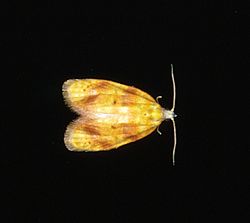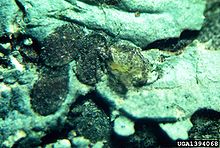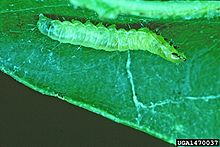- Acleris semipurpurana
-
Oak leaftier moth 
Scientific classification Kingdom: Animalia Phylum: Arthropoda Class: Insecta Order: Lepidoptera Family: Tortricidae Genus: Acleris Species: A. semipurpurana Binomial name Acleris semipurpurana
(Kearfott, 1909)Synonyms - Tortrix albicomana var. semipurpurana Kearfott 1905
- Tortrix semipurpurana
- Argyrotoxa semipurpurana
- Croesia semipurpurana
- Tortrix dorsipurpurana Kearfott, 1907
Acleris semipurpurana is a species in the moth family Tortricidae, and one of several species of moth commonly known as Oak leaftier or Oak leaf tier. The larvae feed on the leaves of oak trees in the Eastern United States and southeastern Canada. It can be a major cause of defoliation in oak trees. The loss of leaves can kill or damage the affected trees, which are chiefly in the Lobatae or red oak section of Quercus or oaks.
Adult Acleris semipurpurana moths lay single eggs on oak tree branches in June; these overwinter and hatch the next April. The larvae eat tree buds and young leaves, then tie leaves together with silk (hence the name). They nest and eat inside the tied leaves, then pupate in the leaf litter on the floor in May or June. After a week or two the adult moths emerge, mate and lay the next generation of eggs.
Contents
Life cycle and description
Oak leaftier moths lay their eggs in June each year, typically as single eggs on rough-bark twigs, typically "second year branches".[1][2] The eggs overwinter and hatch in spring of the next year. The larvae (or caterpillars) emerge in April and initially eat the buds of oak trees and young leaves inside them. When fully grown, the larvae are 12 millimetres (0.47 in) long and are "dirty white to light green" with "a pale brown head and black to brown front legs".[2] Other identifying characteristics in the larvae are a long head with a black bar found on the cheek or lower portion, and brown legs on the thorax. The larvae tie leaves together with silk, which gives the insect its common name. The larvae feed and nest inside the tied or folded leaves until they are ready to pupate in mid to late May.[2][3][4]
The larvae leave the trees to pupate, descending to the ground on silken threads. The pupae are commonly found in the leaf litter on the forest floor beneath the oak trees. After one or two weeks in the pupal stage, the adult moths emerge in late May or June. The moths are small with a wingspan of 12 millimetres (0.47 in); the wings have a characteristic bell shape. Wing color can vary considerably. Some forewings are yellow while others have dark brown or even purple markings. The adults mate and lay eggs - only one generation of moths is produced annually. Acleris semipurpurana was first described by Kearfott in 1909.[1][2][3][4][5]
Range and impact
Acleris semipurpurana is found in the eastern United States and adjoining portions of southeastern Canada. It has been found in US states ranging from New York, Massachusetts, Connecticut and Pennsylvania in the northeast to Minnesota and Texas in the west, as well as the Canadian province of Ontario.[2][6][7][8] The oak leaftiers feed mainly trees in the Lobatae or red oak section of Quercus or oak trees: Specifically on Eastern Black Oak, Northern Red Oak, Pin Oak, Scarlet Oak, and Scrub Oak.[1][2] Several species of moths are referred to with the common name Oak leaftier, most from the Tortricidae family, but also from "three other minor families".[9] Of these species Acleris semipurpurana is the most common and one of the most important for defoliation. In addition to the Oak leaftiers, other pest species will often feed on the same trees, including Archips semiferanus and other Oak leafrollers.[9]
The young larvae eat the buds and either destroy developing leaves, or cause leaves to develop with many holes in them. This can severely stress the tree's food reserves, and the older larvae can eat nearly all the remaining leaves, defoliating them.[2] When trees are defoliated two or more years in a row, this leads to "branch dieback, loss of diameter growth, and tree decline".[9] The Oak leaftier has caused "considerable tree mortality", especially in the Appalachian region.[1] Dead wood in affected trees is attacked by fungi such as the shoestring root fungus and wood borers like the twolined chestnut borer.[9] A major outbreak occurred in the 1960s and 1970s in Connecticut, Massachusetts, New York, Pennsylvania, Virginia, and West Virginia.[5] Tiadaghton State Forest in north central Pennsylvania was especially hard hit.[10] Natural methods of pest control usually are sufficient to keep Croesia semipurpurana populations in check, but chemical pesticides are sometimes needed.[3]
References
- ^ a b c d United States Department of Agriculture Forest Service, Northeast, Area State Private Forest, Forest Insect and Disease Management.. A guide to common insects and diseases of forest trees in the northeastern United States. Broomall, Pennsylvania. p. 123. http://www.forestpests.org/northeast/oakleaftier.html. Retrieved 2009-11-15. Note: this is published on the www.forestpests.org website with the title "Oak Leaftiers: Acleris semipurpurana (Kearfott)"
- ^ a b c d e f g Talerico, R. L. (1978). "Major hardwood defoliators of the Eastern United States.". United States Department of Agriculture, Home and Garden Bulletin 224. http://www.forestpests.org/hardwood/oakleaftiers.html. Retrieved 2009-10-31. Note: this is published on the www.forestpests.org website with the title "Oak leaftier: Acleris semipurpurana"
- ^ a b c "Oak Pests - A Guide to Major Insects, Diseases, Air Pollution, and Chemical Injury: Minor Defoliators". United States Department of Agriculture Forest Service, Forest Health Protection, Southern Region. http://www.fs.fed.us/r8/foresthealth/pubs/oakpests/p14_15.html. Retrieved 2009-10-31.
- ^ a b "The Lepidoptera of Wayne County, Ohio". Ohio State University OARDC. http://www.oardc.ohio-state.edu/rb1192/single.asp?ID=62. Retrieved 2009-10-31.
- ^ a b United States Department of Agriculture Forest Service (1998). "Pest Alert Oak leaftier and Oak leafroller" (PDF). www.forestpests.org. http://www.forestpests.org/acrobat/oakleaf.pdf. Retrieved 2009-10-31.
- ^ Beckwith, R. C. (November 1963). "An Oak Leaf Tier, Acleris semipurpurana (Lepidoptera: Tortricidae) in Connecticut". Annals of the Entomological Society of America 56 (6): 741–744. http://www.ingentaconnect.com/content/esa/aesa/1963/00000056/00000006/art00006. Retrieved 2009-10-31.
- ^ "Natural Heritage Information Centre". Ontario Ministry of Natural Resources. http://nhic.mnr.gov.on.ca/MNR/nhic/elements/el_report.cfm?elid=194238. Retrieved 2009-10-31.
- ^ "Forest Health in Ontario, 2006". Ontario Ministry of Natural Resources. http://www.mnr.gov.on.ca/STEL02_197109.pdf. Retrieved 2009-11-01.[dead link]
- ^ a b c d Snowden, Parker (December 1990). "How to Distinguish Oak Leaftiers From Leafrollers". United States Department of Agriculture Forest Service, Northeastern Area State & Private Forestry. http://www.na.fs.fed.us/spfo/pubs/howtos/ht_oakpests/oakpests.htm. Retrieved 2009-10-31.
- ^ Thorpe, R.R. (1997). The Crown Jewel of Pennsylvania: The State Forest System. Pennsylvania Forestry Association, Pennsylvania Department of Conservation and Natural Resources and the U.S. Forest Service. pp. 68–70. OCLC 37033507.
External links

This Tortricinae-related article is a stub. You can help Wikipedia by expanding it.


